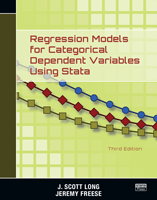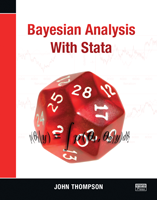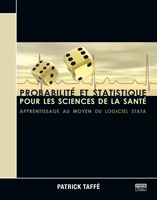Regression Models for Categorical Dependent Variables Using Stata, Third Edition
| Authors: | J. Scott Long and Jeremy Freese |
| Copyright: | 2014 |
| ISBN: | 978-1-59718-111-2 |
| Pages: | 589 |
| Price: | $64.00 |

Regression Models for Categorical Dependent Variables Using Stata, Third Edition, by J. Scott Long and Jeremy Freese, is an essential reference for those who use Stata to fit and interpret regression models for categorical data. Although regression models for categorical dependent variables are common, few texts explain how to interpret such models; this text decisively fills the void.
The third edition is divided into two parts. Part I begins with an excellent introduction to Stata and follows with general treatments of the estimation, testing, fitting, and interpretation of models for categorical dependent variables. The book is thus accessible to new users of Stata and those who are new to categorical data analysis. Part II is devoted to a comprehensive treatment of estimation and interpretation for binary, ordinal, nominal, and count outcomes.
Readers familiar with previous editions will find many changes in the third edition. An entire chapter is now devoted to interpretation of regression models using predictions. This concept is explored in greater depth in Part II. The authors also discuss how many improvements made to Stata in recent years—factor variables, marginal effects with margins, plotting predictions using marginsplot—facilitate analysis of categorical data.
The authors advocate a variety of new methods that use predictions to interpret the effect of variables in regression models. Readers will find all discussion of statistical concepts firmly grounded in concrete examples. All the examples, datasets, and author-written commands are available on the authors' website, so readers can easily replicate the examples with Stata.
Examples in the new edition also illustrate changes to the authors' popular SPost commands after a recent rewrite inspired by the authors' evolving views on interpretation. Readers will note that SPost now takes full advantage of the power of the margins command and the flexibility of factor-variable notation. Long and Freese also provide a suite of new commands, including mchange, mtable, mgen, and mlincom. These commands complement margins, aiding model interpretation, hypothesis testing, and model diagnostics. They offer the same syntactical convenience features that users of Stata expect, for example including powers or interactions of covariates in regression models and seamlessly working with complex survey data. The authors also discuss how to use these commands to estimate marginal effects, either averaged over the sample or evaluated at fixed values of the regressors.
The third edition of Regression Models for Categorical Dependent Variables Using Stata continues to provide the same high-quality, practical tutorials of previous editions. It also offers significant improvements over previous editions—new content, updated information about Stata, and updates to the authors' own commands. This book should be on the bookshelf of every applied researcher analyzing categorical data and is an invaluable learning resource for students and others who are new to categorical data analysis.
Bayesian Analysis with Stata
| Author: | John Thompson |
| Copyright: | 2014 |
| ISBN: | 978-1-59718-141-9 |
| Pages: | 279 |
| Price: | $48.00 |

Bayesian Analysis with Stata is a complete guide to using Stata for Bayesian analysis. It contains just enough theoretical and foundational material to be useful to all levels of users interested in Bayesian statistics, from neophytes to aficionados.
The book is careful to introduce concepts and coding tools incrementally so that there are no steep patches or discontinuities in the learning curve. The content helps the user see exactly what computations are done for simple standard models and shows the user how those computations are implemented. Understanding these concepts is important for users because Bayesian analysis lends itself to custom or very complex models, and users must be able to code these themselves. Bayesian Analysis with Stata is wonderful because it goes through the computational methods three times—first using Stata's ado-code, then using Mata, and finally using Stata to run the MCMC chains with WinBUGS or OpenBUGS. This reinforces the material while making all three methods accessible and clear. Once the book explains the computations and underlying methods, it satisfies the user's yearning for more complex models by providing examples and advice on how to implement such models. The book covers advanced topics while showing the basics of Bayesian analysis—which is quite an achievement.
Bayesian Analysis with Stata presents all the material using real datasets rather than simulated datasets, and there are many exercises that also use real datasets. There is also a chapter on validating code for users who like to learn by simulating models and recovering the known models. This provides users with the opportunity to gain experience in assessing and running Bayesian models and teaches users to be careful when doing so.
The book starts by discussing the principles of Bayesian analysis and by explaining the underlying thought process. It then builds from the ground up, showing users how to write evaluators for posteriors in simple models and how to speed them up using algebraic simplification.
Of course, this type of evaluation is useful only in very simple models, so the book then addresses the MCMC methods used throughout the Bayesian world. Once again, this starts from the fundamentals, beginning with the Metropolis–Hastings algorithm and moving on to Gibbs samplers. Because the latter are much quicker to use but are often intractable, the book thoroughly explains the specialty tools of Griddy sampling, slice sampling, and adaptive rejection sampling.
After discussing the computational tools, the book changes its focus to the MCMC assessment techniques needed for a proper Bayesian analysis; these include assessing convergence and avoiding problems that can arise from slowly mixing chains. This is where burn-in gets treated, and thinning and centering are used for performance gains.
The book then returns its focus to computation. First, it shows users how to use Mata in place of Stata's ado-code; second, it demonstrates how to pass data and models to WinBUGS or OpenBUGS and retrieve its output. Using Mata speeds up evaluation time. However, using WinBUGS or OpenBUGS opens a toolbox that reduces the amount of custom programming needed for complex models. This material is easy for the book to introduce and explain because it has already laid the conceptual and computational groundwork.
The book finishes with detailed chapters on model checking and selection, followed by a series of case studies that introduce extra modeling techniques and give advice on specialized Stata code. These chapters are very useful because they allow the book to be a self-contained introduction to Bayesian analysis while providing additional information on models that are normally beyond a basic introduction.
Probabilité et Statistique pour les Sciences de la Santé: Apprentissage au Moyen du Logiciel Stata
| Author: | Patrick Taffé |
| Copyright: | 2014 |
| ISBN: | 978-1-59718-145-7 |
| Pages: | 559 |
| Price: | $58.00 |

Probabilité et Statistique pour les Sciences de la Santé: Apprentissage au Moyen du Logiciel Stata, par Patrick Taffé, se veut un livre différent de nombreux ouvrages théoriques traitant des probabilités et de la statistique. Cet ouvrage (en français) non seulement présente, de façon rigoureuse, les concepts et méthodes statistiques, mais aussi utilise des exemples concrets pour illustrer chaque concept théorique nouvellement introduit. Le lecteur va apprendre à réaliser des analyses au moyen de Stata, basé sur des vraies données. De nombreuses illustrations et nombreux exemples d'applications sont donnés pour apprendre au lecteur à mettre en pratique les techniques d'analyse. Enfin, des exercices à réaliser avec Stata et impliquant le plus souvent un petit jeu de données, sont proposés à la fin de chaque section afin de mettre en oeuvre les connaissances nouvellement acquises.
L'ouvrage s'adresse en premier lieu au chercheur dans le domaine des sciences de la santé (médecin, infirmière et infirmier, épidémiologue, biologiste, biostatisticien, etc.), qu'il soit débutant ou qu'il maitrise déjà les concepts de base de la statistique, mais aussi aux chercheurs d'autres domaines (économie, psychologie, démographie, géographie, etc.) qui désirent acquérir les fondements de la statistique.
Lisez la revue intégrale du livre >>







